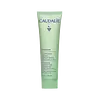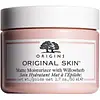What's inside
What's inside
 Key Ingredients
Key Ingredients

 Benefits
Benefits

 Concerns
Concerns

 Ingredients Side-by-side
Ingredients Side-by-side

Water
Skin ConditioningButylene Glycol
HumectantCoco-Caprylate/Caprate
EmollientVitis Vinifera Fruit Water
Skin ConditioningSilica
AbrasiveSqualane
EmollientGlycerin
HumectantTapioca Starch
Glyceryl Stearate
EmollientIsostearyl Isostearate
EmollientPalmitoyl Grape Seed Extract
Skin ConditioningAlcohol Denat.
AntimicrobialAcrylates/C10-30 Alkyl Acrylate Crosspolymer
Emulsion StabilisingCaprylyl Glycol
EmollientXanthan Gum
EmulsifyingEnantia Chlorantha Bark Extract
Skin ConditioningPentylene Glycol
Skin ConditioningPotassium Cetyl Phosphate
EmulsifyingVitis Vinifera Juice
AntioxidantTocopherol
AntioxidantHelianthus Annuus Seed Oil
EmollientSodium Phytate
Citric Acid
BufferingPelargonium Graveolens Flower Oil
MaskingSodium Hydroxide
BufferingSodium Carboxymethyl Beta-Glucan
CleansingMentha Piperita Oil
MaskingCitral
PerfumingCymbopogon Citratus Leaf Oil
MaskingSodium Benzoate
MaskingRosmarinus Officinalis Leaf Oil
MaskingCitronellol
PerfumingMaltodextrin
AbsorbentOrthosiphon Stamineus Extract
Skin ConditioningPotassium Sorbate
PreservativeLavandula Hybrida Oil
EmollientMelissa Officinalis Leaf Oil
MaskingOleanolic Acid
Skin ConditioningGeraniol
PerfumingLinalool
PerfumingLimonene
PerfumingWater, Butylene Glycol, Coco-Caprylate/Caprate, Vitis Vinifera Fruit Water, Silica, Squalane, Glycerin, Tapioca Starch, Glyceryl Stearate, Isostearyl Isostearate, Palmitoyl Grape Seed Extract, Alcohol Denat., Acrylates/C10-30 Alkyl Acrylate Crosspolymer, Caprylyl Glycol, Xanthan Gum, Enantia Chlorantha Bark Extract, Pentylene Glycol, Potassium Cetyl Phosphate, Vitis Vinifera Juice, Tocopherol, Helianthus Annuus Seed Oil, Sodium Phytate, Citric Acid, Pelargonium Graveolens Flower Oil, Sodium Hydroxide, Sodium Carboxymethyl Beta-Glucan, Mentha Piperita Oil, Citral, Cymbopogon Citratus Leaf Oil, Sodium Benzoate, Rosmarinus Officinalis Leaf Oil, Citronellol, Maltodextrin, Orthosiphon Stamineus Extract, Potassium Sorbate, Lavandula Hybrida Oil, Melissa Officinalis Leaf Oil, Oleanolic Acid, Geraniol, Linalool, Limonene
Water
Skin ConditioningDimethicone
EmollientAlcohol Denat.
AntimicrobialGlycerin
HumectantSilica
AbrasiveButylene Glycol
HumectantCitrus Aurantium Dulcis Peel Oil
MaskingCitrus Limon Peel Oil
MaskingPelargonium Graveolens Flower Oil
MaskingLavandula Angustifolia Oil
MaskingAmyris Balsamifera Bark Oil
MaskingCitrus Aurantium Bergamia Fruit Oil
MaskingEugenia Caryophyllus Leaf Oil
MaskingRosa Damascena Flower Oil
MaskingEucalyptus Globulus Leaf Oil
PerfumingZingiber Officinale Root Oil
MaskingMentha Viridis Leaf Oil
AstringentLimonene
PerfumingLinalool
PerfumingCitronellol
PerfumingCitral
PerfumingGeraniol
PerfumingEugenol
PerfumingDimethicone Crosspolymer
Emulsion StabilisingAmmonium Acryloyldimethyltaurate/Vp Copolymer
Pyrus Malus Fruit Extract
Skin ConditioningCucumis Sativus Fruit Extract
EmollientEpilobium Angustifolium Flower/Leaf/Stem Extract
Skin ConditioningCistus Incanus Flower/Leaf/Stem Extract
Skin ConditioningSucrose
HumectantBambusa Vulgaris Extract
Skin ConditioningPisum Sativum Extract
Skin ConditioningCastanea Sativa Seed Extract
Skin ConditioningAlbizia Julibrissin Bark Extract
MaskingSalicylic Acid
MaskingCaffeine
Skin ConditioningArginine
MaskingSodium Hyaluronate
HumectantScutellaria Baicalensis Root Extract
AstringentLaminaria Saccharina Extract
Skin ProtectingLaminaria Digitata Extract
Skin ProtectingPhospholipids
Skin ConditioningHydrolyzed Jojoba Esters
Skin ConditioningGlucosamine Hcl
Lauryl PEG-9 Polydimethylsiloxyethyl Dimethicone
Skin ConditioningDimethicone/Vinyl Dimethicone Crosspolymer
Skin ConditioningCaprylyl Glycol
EmollientAcrylates/C10-30 Alkyl Acrylate Crosspolymer
Emulsion StabilisingTocopheryl Acetate
AntioxidantTromethamine
BufferingSilica Silylate
EmollientHexylene Glycol
EmulsifyingSodium Polyacrylate
AbsorbentDisodium EDTA
Phenoxyethanol
PreservativeMica
Cosmetic ColorantCI 77891
Cosmetic ColorantCI 77491
Cosmetic ColorantWater, Dimethicone, Alcohol Denat., Glycerin, Silica, Butylene Glycol, Citrus Aurantium Dulcis Peel Oil, Citrus Limon Peel Oil, Pelargonium Graveolens Flower Oil, Lavandula Angustifolia Oil, Amyris Balsamifera Bark Oil, Citrus Aurantium Bergamia Fruit Oil, Eugenia Caryophyllus Leaf Oil, Rosa Damascena Flower Oil, Eucalyptus Globulus Leaf Oil, Zingiber Officinale Root Oil, Mentha Viridis Leaf Oil, Limonene, Linalool, Citronellol, Citral, Geraniol, Eugenol, Dimethicone Crosspolymer, Ammonium Acryloyldimethyltaurate/Vp Copolymer, Pyrus Malus Fruit Extract, Cucumis Sativus Fruit Extract, Epilobium Angustifolium Flower/Leaf/Stem Extract, Cistus Incanus Flower/Leaf/Stem Extract, Sucrose, Bambusa Vulgaris Extract, Pisum Sativum Extract, Castanea Sativa Seed Extract, Albizia Julibrissin Bark Extract, Salicylic Acid, Caffeine, Arginine, Sodium Hyaluronate, Scutellaria Baicalensis Root Extract, Laminaria Saccharina Extract, Laminaria Digitata Extract, Phospholipids, Hydrolyzed Jojoba Esters, Glucosamine Hcl, Lauryl PEG-9 Polydimethylsiloxyethyl Dimethicone, Dimethicone/Vinyl Dimethicone Crosspolymer, Caprylyl Glycol, Acrylates/C10-30 Alkyl Acrylate Crosspolymer, Tocopheryl Acetate, Tromethamine, Silica Silylate, Hexylene Glycol, Sodium Polyacrylate, Disodium EDTA, Phenoxyethanol, Mica, CI 77891, CI 77491
 Reviews
Reviews

Ingredients Explained
These ingredients are found in both products.
Ingredients higher up in an ingredient list are typically present in a larger amount.
Acrylates/C10-30 Alkyl Acrylate Crosspolymer is a synthetic polymer. It is used to thicken and improve the texture of products. Due to its properties, it can prevent water and oil ingredients from separating.
Alcohol Denat. is an alcohol with a denaturant property. It is created by mixing ethanol with other additives.
This ingredient gets a bad rep because it is irritating and drying - mostly due to its astringent property. Astringents draw out natural oils in tissue, constricting pores and leaving your skin dried out.
However, alcohol denat. is not all that bad.
Due to its low molecular weight, alcohol denat. tends to evaporate quickly. One study on pig skin found half of applied alcohol evaporated in 10 seconds and less than 3% stayed on skin.
This also helps other ingredients become better absorbed upon application.
Studies are conflicted about whether this ingredient causes skin dehydration. One study from 2005 found adding emollients to propanol-based sanitizer decreased skin dryness and irritation. Another study found irritation only occurs if your skin is already damaged.
Small amounts of alcohol are generally tolerated by oily skin or people who live in humid environments.
The rule of thumb is if this alcohol is near the end of an ingredients list, it will probably not affect your skin much.
Also...
This ingredient has antimicrobial and solvent properties.
The antimicrobial property helps preserve products and increase their shelf life. As a solvent, it helps dissolve other ingredients.
Other types of astringent alcohols include:
Learn more about Alcohol Denat.Butylene Glycol (or BG) is used within cosmetic products for a few different reasons:
Overall, Butylene Glycol is a safe and well-rounded ingredient that works well with other ingredients.
Though this ingredient works well with most skin types, some people with sensitive skin may experience a reaction such as allergic rashes, closed comedones, or itchiness.
Learn more about Butylene GlycolCaprylyl Glycol is a humectant and emollient, meaning it attracts and preserves moisture.
It is a common ingredient in many products, especially those designed to hydrate skin. The primary benefits are retaining moisture, skin softening, and promoting a healthy skin barrier.
Though Caprylyl Glycol is an alcohol derived from fatty acids, it is not the kind that can dry out skin.
This ingredient is also used as a preservative to extend the life of products. It has slight antimicrobial properties.
Learn more about Caprylyl GlycolCitral is a fragrance and used to add a lemon-like scent to products. It is both naturally found in plants and created synthetically. In plants, it is commonly occurring in lemon myrtle, lemongrass, lemon tea-tree, lemon verbena, and other citruses.
The EU mandates Citral be listed separately as a fragrance. It is a known allergen and may cause contact dermatitis. Citral can also used as a masking ingredient.
The term 'fragrance' is not regulated in many countries. In many cases, it is up to the brand to define this term. For instance, many brands choose to label themselves as "fragrance-free" because they are not using synthetic fragrances. However, their products may still contain ingredients such as essential oils that are considered a fragrance.
The term 'citral' is a collective term for two geometric isomers: geranial/Citral A and neral/Citral B.
Learn more about CitralCitronellol is used to add fragrance/parfum to a product. It is often derived from plants such as roses. In fact, it can be found in many essential oils including geranium, lavender, neroli, and more. The scent of Citronellol is often described as "fresh, grassy, and citrus-like".
Since the Citronellol molecule is already unstable, Citronellol becomes irritating on the skin when exposed to air.
Citronellol is a modified terpene. Terpenes are unsaturated hydrocarbons found in plants. They make up the primary part of essential oils.
Citronellol is not able to be absorbed into deeper layers of the skin. It has low permeability,
Citronellol is also a natural insect repellent.
Learn more about CitronellolGeraniol is used to add fragrance/parfum to a product. It is the main component of citronellol. It is a monoterpenoid and an alcohol.
Monoterpenes are naturally found in many parts of different plants.
Geraniol can be found in many essential oils including Rose Oil and Citronella Oil. The scent of Geraniol is often described as "rose-like". Many foods also contain Geraniol for fruit flavoring.
Geraniol can irritate the skin when exposed to air. However, irritation depends on the ability of geraniol to penetrate into the skin. In general, geraniol is not able to penetrate skin easily.
Geraniol is colorless and has low water-solubility. However, it is soluble in common organic solvents.
Like citronellol, it is a natural insect repellent.
2,6-Octadien-1-ol, 3,7-dimethyl-, (2E)-
Learn more about GeraniolGlycerin is already naturally found in your skin. It helps moisturize and protect your skin.
A study from 2016 found glycerin to be more effective as a humectant than AHAs and hyaluronic acid.
As a humectant, it helps the skin stay hydrated by pulling moisture to your skin. The low molecular weight of glycerin allows it to pull moisture into the deeper layers of your skin.
Hydrated skin improves your skin barrier; Your skin barrier helps protect against irritants and bacteria.
Glycerin has also been found to have antimicrobial and antiviral properties. Due to these properties, glycerin is often used in wound and burn treatments.
In cosmetics, glycerin is usually derived from plants such as soybean or palm. However, it can also be sourced from animals, such as tallow or animal fat.
This ingredient is organic, colorless, odorless, and non-toxic.
Glycerin is the name for this ingredient in American English. British English uses Glycerol/Glycerine.
Learn more about GlycerinLimonene is a fragrance that adds scent and taste to a formulation.
It's found in the peel oil of citrus fruits and other plants such as lavender and eucalyptus. The scent of limonene is generally described as "sweet citrus".
Limonene acts as an antioxidant, meaning it helps neutralize free radicals.
When exposed to air, oxidized limonene may sensitize the skin. Because of this, limonene is often avoided by people with sensitive skin.
The term 'fragrance' is not regulated in many countries. In many cases, it is up to the brand to define this term. For instance, many brands choose to label themselves as "fragrance-free" because they are not using synthetic fragrances. However, their products may still contain ingredients such as essential oils that are considered a fragrance.
Learn more about LimoneneLinalool is a fragrance and helps add scent to products. It's derived from common plants such as cinnamon, mint, citrus, and lavender.
Like Limonene, this ingredient oxidizes when exposed to air. Oxidized linalool can cause allergies and skin sensitivity.
This ingredient has a scent that is floral, spicy tropical, and citrus-like.
Learn more about LinaloolPelargonium Graveolens Flower Oil is the pressed oil of the Rose Geranium plant. It is volatile, meaning it evaporates off the skin.
Fragrant components of Rose Geranium include citronellol and geraniol. These may cause allergies and skin-sensitivity. We recommend speaking with a professional if you have any concerns.
The scent of Rose Geranium closely resembles traditional roses.
Learn more about Pelargonium Graveolens Flower OilSilica, also known as silicon dioxide, is a naturally occurring mineral. It is used as a fine, spherical, and porous powder in cosmetics.
Though it has exfoliant properties, the function of silica varies depending on the product.
The unique structure of silica enhances the spreadability and adds smoothness, making it a great texture enhancer.
It is also used as an active carrier, emulsifier, and mattifier due to its ability to absorb excess oil.
In some products, tiny microneedles called spicules are made from silica or hydrolyzed sponge. When you rub them in, they lightly polish away dead skin layers and enhance the penetration of active ingredients.
Learn more about SilicaWater. It's the most common cosmetic ingredient of all. You'll usually see it at the top of ingredient lists, meaning that it makes up the largest part of the product.
So why is it so popular? Water most often acts as a solvent - this means that it helps dissolve other ingredients into the formulation.
You'll also recognize water as that liquid we all need to stay alive. If you see this, drink a glass of water. Stay hydrated!
Learn more about Water